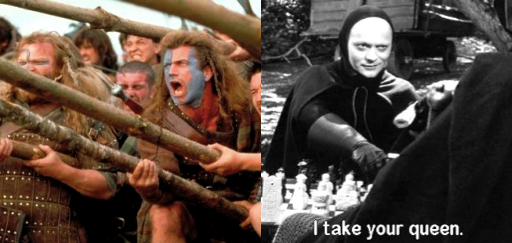I want to tackle a simple distinction in Chess I think helps beginning players immensely. This falls into the category of Inner Game. When I’m teaching people who are new to Chess about strategy beyond how to move the pieces there’s one hang-up we almost always face. It’s this: the distinction between Attacking and Killing.
I know killing isn’t the “proper term” for this. In Chess lingo, Killing is called “Taking.” I’m talking about when a piece, a Knight for example, moves onto the space of an enemy piece, removing it from the board. If you’ve played Chess for 10 minutes you’ll know what I’m talking about.
However, it’s not Killing or Taking that confuses Chess Beginners. It’s Attacking. I’m going to explain why understanding Attacking and how it is separate from Killing is important.
Definition: Attacking is when a piece is directly in position to take another piece. And when I say directly I mean DIRECTLY as in the next move. In the example below, the White Knight is Attacking Black’s Pawn.
What this means for Black is his Pawn is gone in 1 move if he doesn’t do anything about it. This should be an immediate red flag to Black that he needs to protect his piece in the NEXT move otherwise he can say bye-bye to his King Pawn.
For some this may seem obvious, but the fact of the matter is…there IS a single moment in time when a beginning Chess player must make this distinction in his or her head, and if I can help you make it faster, I’ll feel quite good about my day.
If your piece is under attack, you might think, “welp, he’s dead, might as well just give up the game.” But wait a second. You have more options. The fact that you have more options is one of the most important reasons why you must understand Attacking vs. Killing.
When your piece is under attack, there are a few easy things you can do:
1. Move the piece
2. Protect the piece
For example, if Black is thinking in terms of Attacks, he’ll realize he’s under attack and protect his piece.
White is not likely to take the Pawn now that it’s protected. But if you’re thinking in terms of pieces Killed or not Killed, and you don’t realize your pieces is under attack. Here’s what will happen:
White Knight takes the Pawn. Black has lost a piece and the center. Yes, Black will probably mourn the loss of the Pawn, but if he was thinking in terms of Attacking, he could easily have prevented it.
Here’s why it’s important to know the difference between Attacking vs. Killing. If you think in terms of your pieces Killed or not Killed. You’re always going to be a step behind. Chess is about predicting, anticipating. If you’re looking for and recognizing attacks, and what to do about them, you’re ahead of the game, not behind.
What can you do to learn the difference between Attacking and Killing better? Use Internal Narration. When you see that you’re under attack, tell yourself. “My Pawn is under attack by the Knight.” Or, “my Knight is Attacking his Pawn.” After a while it becomes second nature to recognize and act on it.
Do you struggle with Attacking vs. Killing? Have you found a way to overcome it?
Let us know in the comments.
Maxen R. Tarafa
Categories: Uncategorized

Leave a Reply